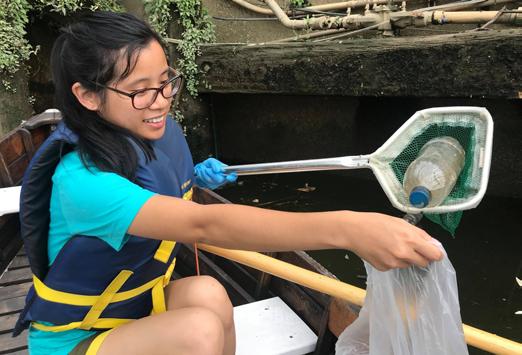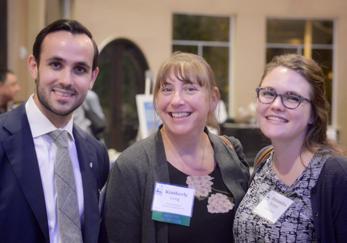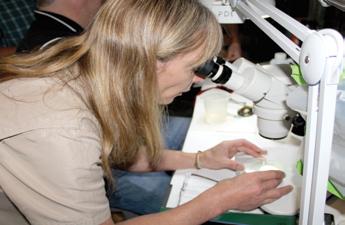
12 minute read
Birding in the Estuary
by Kate Layton, Marketing and Communications Manager, Partnership for the Delaware Estuary
A snowy egret perches high on a bare branch at Bombay Hook National Wildlife Refuge. It stretches its long wings while 200 feet away, camera shutters click to capture the bird’s illuminated plumage. Bird watchers and photographers are as common a sight at the Smyrna, Delaware wildlife refuge as the birds and other animals that live there. “Birds are a gateway for a deeper interest in nature,” said Jeffrey Gordon, president of the American Birding Association. “For many reasons, they just capture our imagination.”
Advertisement
The ABA, headquartered in Delaware City, Delaware, is a non-profit organization that is dedicated to recreational birding in the United States and Canada. Among other birding activities, it holds heron watches near its office building, and summer camps for birding, including one that involves a ferry boat ride from Lewes, Delaware to Cape May, New Jersey. Some bird watchers come from as far as Seattle to see the natural bird areas within the Delaware Estuary.
The Delaware Estuary is alive with places to watch birds, and a place that’s full of bird and habitat conservation areas. Some places offer both accessibility and conservation conditions, some offer one or the other. Bombay Hook for example, which receives visitors year-round, is a designated Important Bird and Biodiversity Area, or IBA.
An IBA is an area that has been identified as globally important for the conservation of bird populations. BirdLife International, a global conservation partnership, determines these sites using criteria such as species, ornithological importance from the surrounding habitat, population numbers, and whether species are threatened or endangered. The National Audubon Society administers the IBA program in the United States.
There are more than 12,000 IBAs worldwide. Of those, 1,700 are in the U.S. with 96 IBAs throughout Delaware Estuary focus area. IBAs can attract bird watchers and visitors from around the world. They can be a starting point for fledgling birders. But sometimes, what makes for an Important Bird Area is different from an important area for birding. Sometimes conditions overlap, and sometimes they don’t. Gordon likens this distinction to a tour of a museum. There’s lots to see and appreciate in the areas that are accessible to the public.
“But really, the best and most important things

“Birds are a gateway for a deeper interest in nature. For many reasons, they just capture our imagination.” — Jeffrey Gordon,
President of the
American Birding
Association A snowy egret shows off its wings at Bombay Hook National Wildlife Preserve in Smyrna, Delaware CREDIT: Kate Layton A grey catbird sits on a branch at Bombay Hook National Wildlife Preserve in Smyrna, Delaware. CREDIT: Kate Layton A group of birders spot something interesting at White Clay Creek State Park in Newark. CREDIT: Rick Darke


are often in storage and preserved,” Gordon said.
An IBA might be in the middle of a marsh or another area that provides great conditions for habitat and breeding, but not in easy reach for bird watchers. For example, Delaware has a large block of salt marsh between the Chesapeake and Delaware Canal and Lewes that provides acres of wildlife habitat, Gordon said.
“But much of that area is exceedingly difficult to access,” Gordon said, “unless a person has a boat and navigational equipment.”
On the other hand, Gordon said, unconventional spots that are unsuitable as conservation areas can still be great for seeing birds. Eagles and osprey are sometimes visible from Interstate-95, for instance.
IBAs are categorized on global, continental and state levels. National Audubon Society maps show that large parts of the Delaware Estuary fall under all three IBA classifications.
Cape May is world famous as a bird migration spot from summer through late fall. Heislerville Wildlife Management Area in Heislerville, New Jersey, is another great location. Hawk Mountain near Reading, Pennsylvania, Gordon said, used to be a famous as a prime spot to shoot hawks before laws changed to protect birds of prey. Today, it is a famous lookout site for hawk migration in the region, as well as for spotting eagles and falcons migrating south from mid-August through November. It’s also great for hiking in spring and summer. There’s also Prime Hook National Wildlife Refuge near Milton, Delaware, Reed’s Beach in New Jersey and Fairmount Park in Philadelphia which great for both and visitation.
“Our neck of the woods is a phenomenal place to watch birds,” said John Cecil, vice president for stewardship for New Jersey Audubon.
Cecil said that the amount of important birding area within the Delaware Estuary is a sign of its diversity and significance.
“It goes to show that our watershed is still intact,” Cecil said. “The water is providing habitat for species that are rare and for species that are common and abundant.” Cecil was head of the National Audubon Society’s IBA program for nine of his 12 years with the environmental and conservation agency. During that time, Cecil said, Audubon was concerned with creating a network of sites to make sure the habitat was conserved and managed, and species were preserved. Because of the popularity of bird watching, An osprey carries a fish in its talons. National Audubon has agreed to let organizations A redwing blackbird calls for attention at Bombay Hook CREDIT: Lynn Maun, Great Egg Harbor Watershed Association include that factor if they apply for an area to have a state IBA classification, Cecil said. “Some [birders] are more recreational, and some really go the distance because they support the conservation,” Cecil said. “In part, National Wildlife Preserve in Smyrna, Delaware. CREDIT: Kate Layton the IBA program in the United States is attempt to wrap our arms around the birding community and really creating opportunities for all kinds of bird watchers to contribute to bird conservation.” Technology has made birding data more and more sharable. The website Ebird.org, developed by the Cornell Lab of Ornithology, encourages people to contribute their data that tracks hot spots and sightings. Birders also use social networks that can support collection of information and engagement. Part of the appeal of birding is the chance to get away from daily cares and stresses, Gordon said. “Birding is incredibly intergenerational –something that grandparents can do with their grandkids, he said. “Some people just want to get off their couch and see birds in their neighborhood,” he said. “We can also inspire them to do that and open them up to this world that most people don’t even perceive.”S To learn more about the organization, visit www. ABA.org. For more information about IBAs, visit NationalAudubon.org and BirdLife.org.

An AWEsome Fellowship
By Ngoc Kim, Returning fellow, Alliance for Watershed Education of the Delaware River Watershed
Growing up in Camden, New Jersey, I had little exposure to nature. But now, I’m dedicating my life to ecology.
This is my second summer as a fellow with the Alliance for Watershed Education (AWE) of the Delaware River Watershed in Pennsylvania. Each year, I’ve gained new experiences and insights that will serve my career in teaching or ecological research. Each environmental center has offered unique goals for watershed fellows. This alliance is comprised of 23 environmental education centers in New Jersey, Pennsylvania, and Delaware.
During my first year as a watershed fellow, I worked for the John James Audubon Center (JJAC) in Audubon, Pennsylvania. My job was to increase community engagement and improve the Delaware River watershed. I taught students from summer camp groups, after school programs, and children who had limited exposure to nature. In addition, I took care of non-releasable birds on our site. For my capstone projects, I built a rain garden and repaired a riparian buffer to increase native bird and pollinator species, as well as promote a healthy watershed.
This summer, I’m a Watershed Fellow at the Independence Seaport Museum (ISM) in Philadelphia where I am learning a different perspective in environmental and water conservation. Every week, I teach lessons about the Delaware River watershed, guide the museum’s River Ambassadors, and lead cleanups. I’m also working on a few projects. One is the construction of an underwater viewer which enables a person to see underwater without glare from the sun. I’m also building a native garden for birds and pollinator species. I hope these few projects will enhance watershed education programs for all who visit ISM.
Each environmental center is unique and different from one another. JJAC provides a beautiful ecological scenic view and hiking trails, history lessons, volunteer opportunities, bird watching, and so much more. ISM provides maritime history, internship opportunities, ship tours, diverse science lessons, boat rentals, and more. I encourage you to visit and learn what kinds of activities your nearby nature centers has to offer that you may grow to love. S
Get Ready for an AWEsome Month of Events

By Becca Gregg Sansom, Communications Specialist, The Nature Place, Reading Pennsylvania
River Days events are getting ready to kick off this September at environmental centers throughout Pennsylvania, New Jersey and Delaware.
This year’s River Days events include such activities as biking and boating, waterfront festivals, history hikes, bilingual bird walks, any many, many more. Starting Sept. 15, these exciting events will run through Oct. 15, spanning from the Poconos and Reading, Pennsylvania to Wilmington, Delaware. You’ll be sure to find something for everyone in the family to enjoy this fall.
Coordinated annually through a partnership of 23 centers that make up the Alliance for Watershed Education of the Delaware River (AWE), River Days “is a great time for people to explore, enjoy and engage with their local nature centers while learning about the watershed and their role within it,” said Mica McCullough, AWE’s communications coordinator.
Berks Nature and its events at The Nature Place outside Reading, Pennsylvania, is just one destination that’s part of River Days. A full listing of AWE events can be found online, at www.watershedalliance.org. S “The primary goal is to introduce visitors to their watershed in a fun way,” McCullough said. “If visitors have an AWE-some time at a River Days event, we encourage them to visit the other 22 centers in the Alliance.”
PENNSYLVANIA COAST DAY
11 a.m. to 4 p.m. Saturday, Sept. 15 | Philadelphia/Camden, New Jersey
Celebrate the Delaware River in two states, with one great event! The Partnership for the Delaware Estuary (PDE), Alliance for Watershed Education (AWE), and Center for Aquatic Sciences are teaming up for the Delaware River Festival. It’s a “coast to coast” experience between Philadelphia and Camden, New Jersey that you don’t want to miss. Enjoy festivities on both sides of the river by taking the RiverLink Ferry between the two city waterfronts! The whole event is FREE and fun for the whole family! For more information, and to register for the events, visit PDE’s Facebook page, or visit www. delawareestuary.org
VOLUNTEER FOR CLEAN WATER 9:30 a.m. to 12:30 p.m., Saturday, Sept. 22
Wilmington, Delaware
Looking for a chance to do something for the community? Be a Water Warrior by helping PDE bag oyster shells from local restaurants. Instead of going to a landfill, those shells go back to nature in restoration projects like living shorelines and oyster beds. Volunteers of all ages are welcome to help. Anyone under age 18 must be accompanied by an adult and have a waiver signed by a parent or guardian. More information, including the event’s location, will be made available following registration. Go to PDE’s Facebook page to register via EventBrite, or visit www.delawareestuary.org. Care about clean water and want to do more? Sign up to learn more about clean water initiatives in Delaware and how you can help. Complete this form to sign up for the Clean Water Delaware Campaign newsletter: http://bit.ly/2Aca9Fi.com

Experience the Estuary Celebration
5 to 8:30 p.m., Thursday, September 27 | Claymont, DE
Join us at The Waterfall for the 2018 Experience the Estuary Celebration, our largest fundraiser of the year! This annual celebration attracts more than 350 friends and supporters of the Delaware Estuary. Enjoy an evening of cocktails, our famous 90-minute oyster raw bar, three-course dinner, and auctions. Tickets are on sale now at https://pde18.eventbrite.com. You may also visit www.delawareestuary.org

Jan. 27-31, 2019 | The Grand Hotel, Cape May, New Jersey
Mark your calendar for the 2019 Delaware Estuary Science & Environmental Summit! This three-day conference retreat will bring together scientists, researchers, managers and environmental education specialists to share information. Estuary 2029: Saving our System Through Collaboration, invites attendees to forge new collaborations that promote ecosystem-based science, management and restoration through networking, scientific presentations, special speakers, and panel sessions. For information, visit: www.delawareestuary.org

110 South Poplar Street, Suite 202 Wilmington, DE 19801
ADDRESS SERVICE REQUESTED
US POSTAGE Non-Profit Org PAID Wilmington, DE Permit #1885
HELP US SAVE PAPER. Convert your subscription to email today. It’s easy! Just email ehorsey@delawareestuary.org and provide your name and email address.
The Partnership for the Delaware Estuary: Connecting people, science, and nature for a healthy Delaware River and Bay
Follow us on
The Partnership for the Delaware Estuary, Inc. (PDE), is a private, nonprofit organization established in 1996. The PDE, a National Estuary Program, leads science-based and collaborative efforts to improve the tidal Delaware River and Bay, which spans Delaware, New Jersey, and Pennsylvania. To find out how you can become one of our partners, call the PDE at (800) 445-4935 or visit our website at www. DelawareEstuary.org.
Partnership for the Delaware Estuary, Inc. Jennifer Adkins, Executive Director Tel: (800) 445-4935 / Fax: (302) 655-4991 E-mail: jadkins@DelawareEstuary.org
Environmental Protection Agency Irene Purdy, EPA Region II Tel: (212) 637-3794 / Fax (212) 637-3889 E-mail: purdy.irene@epa.gov Megan Mackey, EPA Region III Tel: (215) 814-5534 / Fax: (215) 814-2301 E-mail: mackey.megan@epa.gov
Pennsylvania Rhonda Manning Department of Environmental Protection Tel: (717) 772-4472 / Fax: (717) 783-4690 Email: rmanning@pa.gov Delaware Kimberly Cole Department of Natural Resources and Environmental Control Tel: (302) 739-9283 / Fax: (302) 739-2048 E-mail:kimberly.cole@state.de.us
New Jersey Jay Springer Department of Environmental Protection Tel: (609) 341-3122 / Fax: (609) 984-6505 E-mail: jay.springer@dep.state.nj.us
Delaware River Basin Commission Kenneth Najjar Tel: (609) 883-9500 ext 256 Fax: (609) 883-9522 E-mail: kenneth.najjar@drbc.state.nj.us Philadelphia Water Department Kelly Anderson Tel: (215) 685-6245 / Fax: (215) 685-6043 Email: kelly.anderson@phila.gov Editor Kate Layton Marketing and Communications Manager Email: klayton@delawareestuary.org UNLESS OTHERWISE NOTED, ALL PHOTOS ARE PROPERTY OF THE PARTNERSHIP FOR THE DELAWARE ESTUARY.
Estuary News encourages reprinting of its articles in other publications. Estuary News is produced four times annually by the Partnership for the Delaware Estuary, Inc. (PDE), under an assistance agreement (CE-99398513-2) with the U.S. Environmental Protection Agency (EPA). The purpose of this newsletter is to provide an open, informative dialogue on issues related to PDE. The viewpoints expressed here do not necessarily represent the views of the PDE or EPA, nor does mention of names, commercial products or causes constitute endorsement or recommendation for use. For information about the PDE, call 1-800-445-4935.



